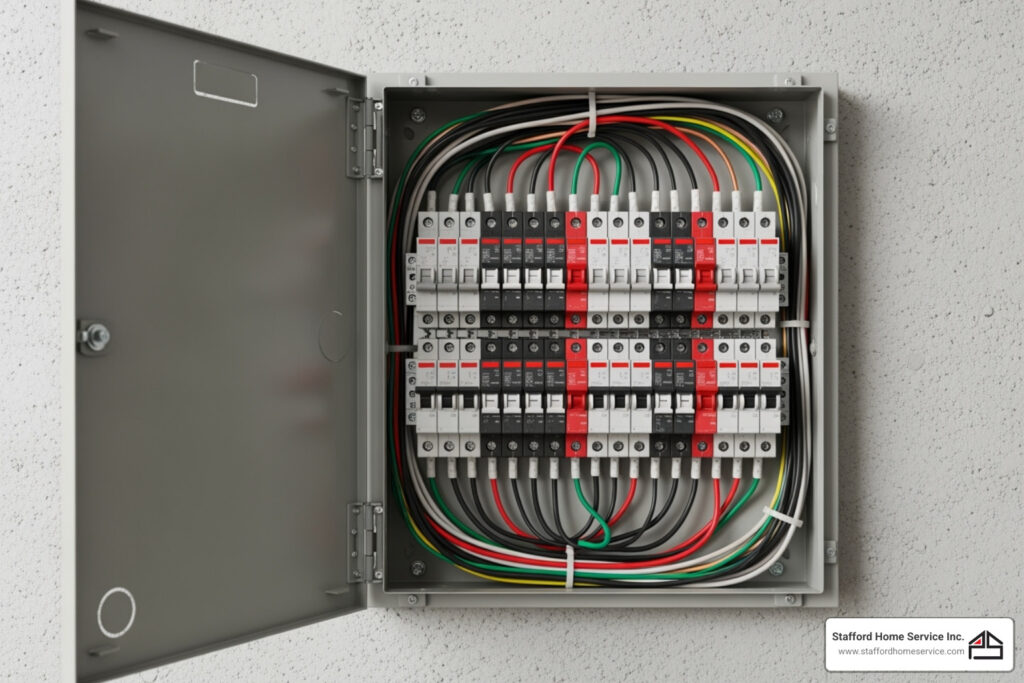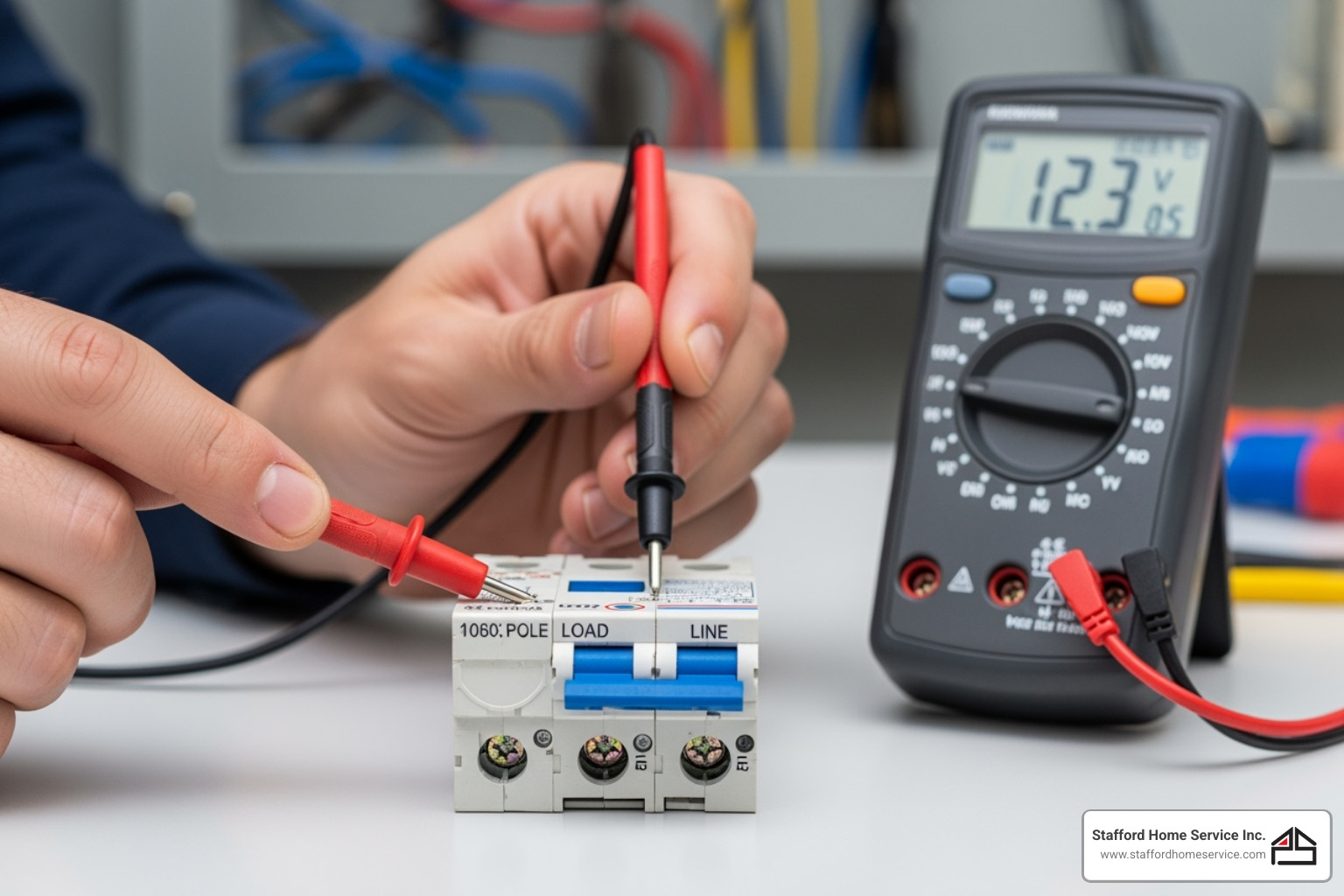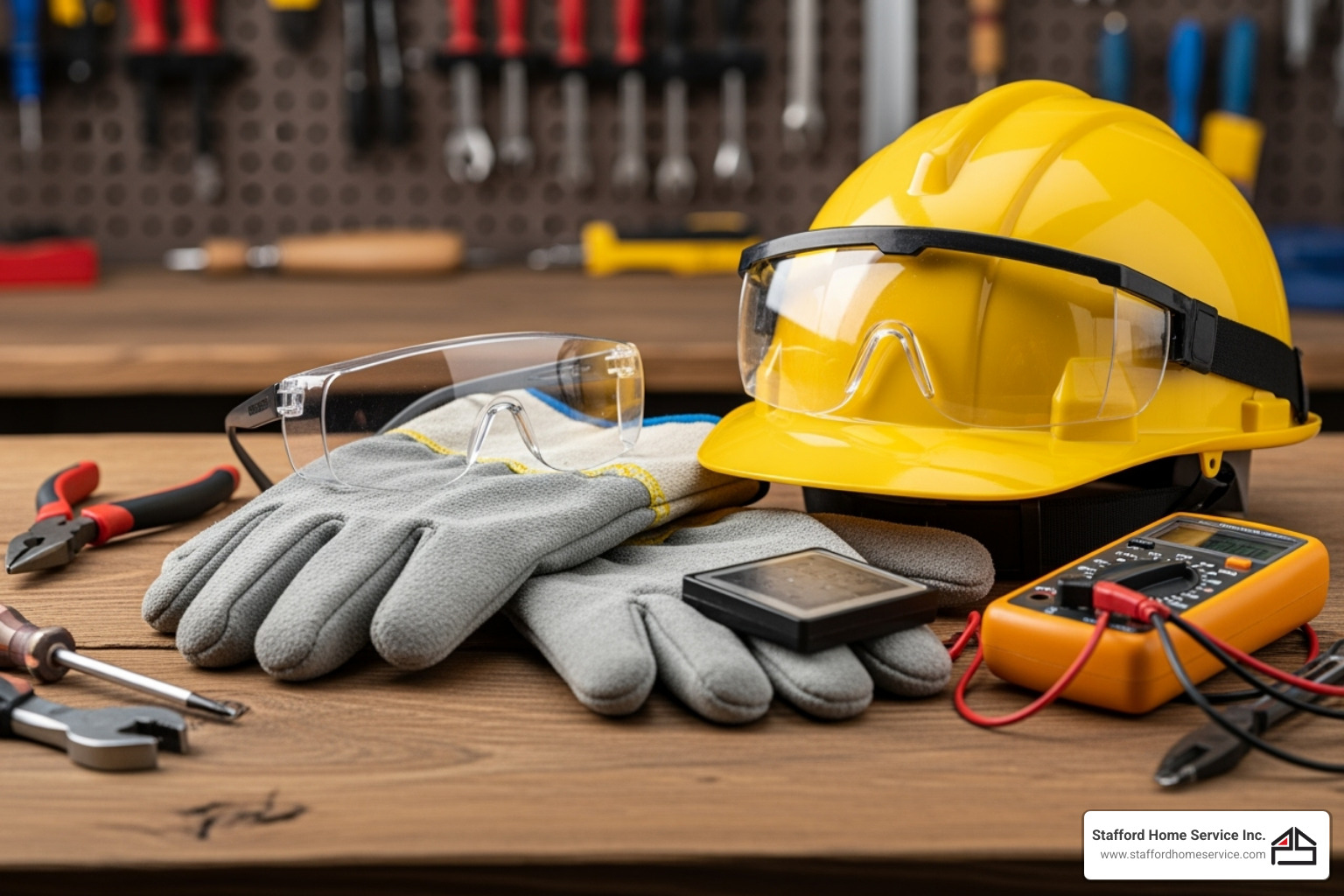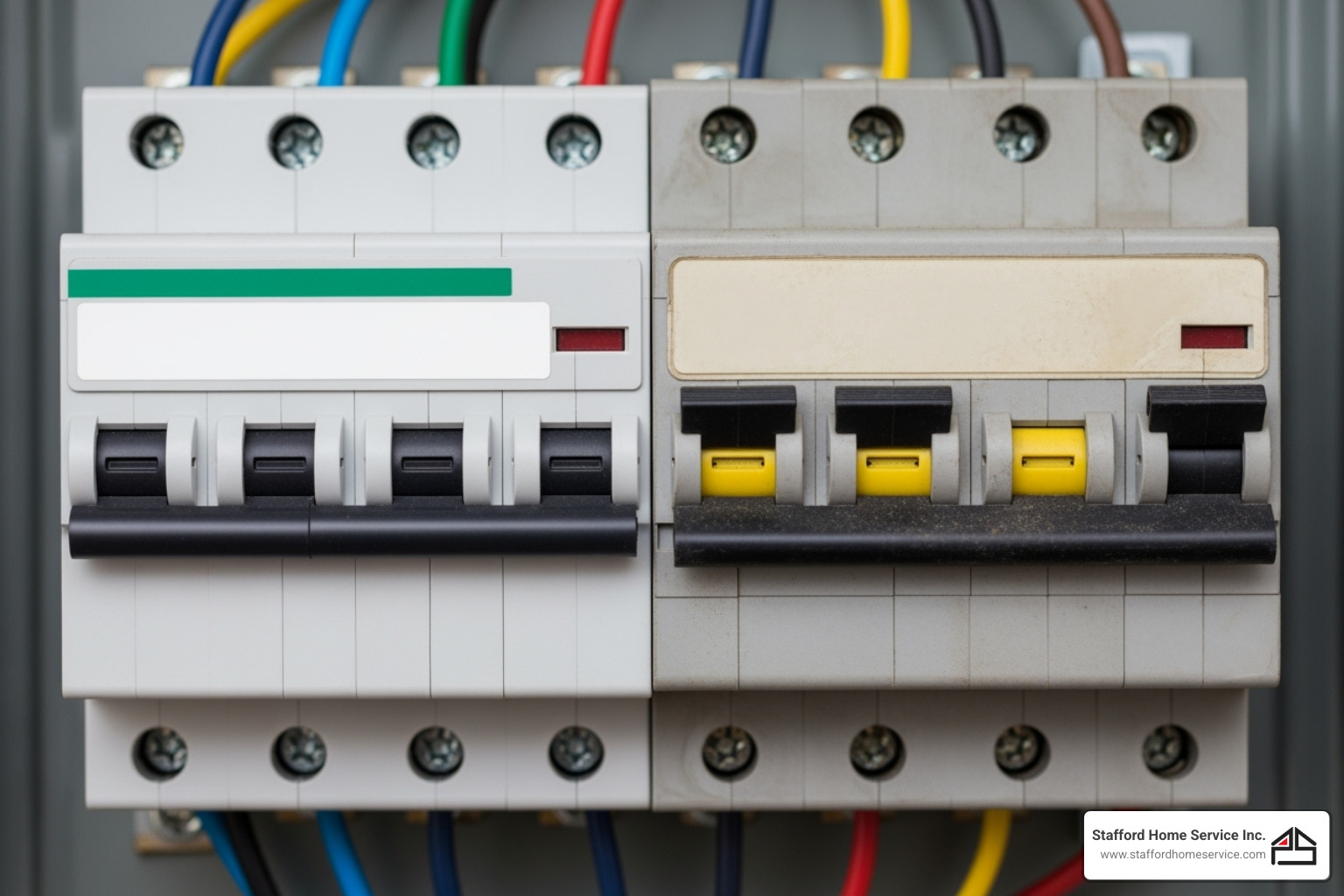Understanding Your Home’s Electrical Guardian
Circuit breaker repair typically involves replacing faulty breakers rather than fixing them, since residential circuit breakers can’t be repaired once they fail. Here’s what you need to know:
Key Signs Your Breaker Needs Replacement:
- Breaker trips frequently or won’t reset
- Burning smell or buzzing sounds from the panel
- Breaker feels hot to the touch
- Visible damage like melted plastic or rust
- Breaker is over 25 years old
When to Call a Professional:
- Any signs of burning, sparking, or melting
- Breaker won’t stay in the “on” position
- Multiple breakers failing simultaneously
- Electrical panel is outdated (Federal Pacific, Zinsco brands)
Circuit breakers are the unsung heroes of your home’s electrical system. These mechanical devices with moving parts act as fail-safes, automatically shutting off power when they detect dangerous conditions like overloads or short circuits. As one industry expert notes: “Circuit breakers are mechanical devices with moving parts and therefore they are the most likely switchgear component to wear out and cause unintended outages.”
Your electrical panel controls everything from your morning coffee maker to your HVAC system. When a breaker fails, it can leave you without power in critical areas of your home – or worse, create safety hazards like electrical fires.
Most residential circuit breakers are designed to last 25-30 years under normal conditions. However, frequent tripping, power surges, and normal wear can shorten their lifespan significantly. The good news? Replacing a faulty breaker is often straightforward when done safely and correctly.
Is Your Breaker Broken? Telltale Signs You Need a Repair or Replacement
Your home’s electrical system usually works quietly, but when a circuit breaker acts up, the signs are hard to ignore. Recognizing these warnings early can prevent bigger problems and keep your family safe.
Flickering lights are often the first hint of trouble. If lights dim when you turn on an appliance or flicker randomly, the breaker might be overloaded or have an internal fault.
Frequent tripping is a clear red flag. Breakers are designed to trip to prevent overloads, but if one trips constantly even after you unplug devices, the breaker itself is likely the problem.
A burning smell near your electrical panel is an immediate cause for concern. It usually means wires are overheating or insulation is melting. Call a professional right away.
Buzzing sounds from your electrical panel are not normal. Humming or buzzing often points to loose connections or a failing breaker that could overheat.
When a breaker feels hot to the touch, take action. While some warmth is normal, excessive heat indicates dangerous overheating that could lead to a fire.
Physical damage is another clear sign that circuit breaker repair (replacement) is needed. Look for melted plastic, rust, corrosion, or discoloration on the breakers.
Don’t forget about breaker age. Even if a 25-year-old breaker seems fine, its internal parts are wearing out and it might fail when you need it most.
Melted plastic around breakers or the panel is a serious fire hazard and requires immediate professional attention.
Here are the 5 key warning signs that demand immediate action:
- Breaker trips repeatedly without explanation
- Burning smell coming from the electrical panel
- Buzzing or humming sounds from the breaker box
- Excessive heat when touching the breaker or panel
- Visible damage like melting, discoloration, or rust
When to Replace a Circuit Breaker Instead of Resetting
Sometimes a simple reset doesn’t solve the problem. Residential circuit breaker repair isn’t really a thing; when a home circuit breaker fails, it needs to be replaced. These devices are sealed units designed to be swapped out.
A breaker that won’t reset is the clearest sign you need a replacement. If you flip it off and firmly back on, but it refuses to stay in the “on” position, the internal mechanism has failed.
A breaker that trips immediately after resetting, even with nothing plugged into that circuit, has serious internal problems or is responding to a dangerous fault condition.
An over 25 years old breaker’s ability to protect your home diminishes significantly as its moving parts wear out.
Visible rust or corrosion spells trouble for electrical connections. Corroded breakers can overheat, fail to trip when needed, or create dangerous arcing.
Known hazardous panels like Federal Pacific Electric (FPE) or Zinsco brands should be replaced regardless of individual breaker failure due to documented safety issues and fire risks.
Diagnosing the Cause: Overload, Short Circuit, or Faulty Breaker
When your breaker trips, it’s protecting your home. Figuring out why helps determine if you need professional circuit breaker repair.
Overloaded circuits are the most common culprit. This happens when you ask more of a circuit than it can handle, like plugging a space heater and a vacuum cleaner into the same circuit.
Short circuit faults are more serious. This occurs when a hot wire touches a neutral wire due to damaged insulation or faulty wiring. The breaker trips instantly to prevent a fire.
Ground faults happen when electricity finds an unintended path to ground, like through water or a person. This is why GFCI breakers are required in wet areas like bathrooms and kitchens.
Testing with a multimeter can help diagnose breaker problems, but it requires shutting off main power and removing the panel cover—a job for professionals. A multimeter can check if the breaker opens and closes but can’t tell you if it will trip correctly under dangerous conditions.
Identifying faulty appliances is often easier and safer. If a breaker keeps tripping, unplug everything on that circuit. Then plug appliances back in one at a time. If the breaker trips after connecting a specific appliance, you’ve found your problem.
If the breaker still trips with nothing connected, the issue is likely the breaker itself or your home’s wiring—both situations that call for professional help.
Your Guide to Professional Circuit Breaker Repair and Replacement
When we talk about circuit breaker repair for your home, we’re almost always talking about replacement. Unlike massive industrial breakers, your home’s circuit breakers are sealed units designed to be swapped out when they fail, not taken apart and fixed.
Residential breakers are built to last for decades, but when their time is up, replacement is the safe, reliable solution. With proper safety precautions and knowledge, replacing a circuit breaker is often more straightforward than many homeowners expect.
Essential Safety Precautions for Circuit Breaker Repair
Electricity doesn’t give second chances. Before opening your electrical panel, safety must be your top priority. If anything feels beyond your comfort level, call a professional. It’s better to be safe than to risk an electrical accident.
Main power shutoff is your first and most critical step. The main breaker at the top or bottom of your panel must be OFF. Even then, the service lugs where power enters your home are still live and dangerous. Never touch those thick cables or connection points.
Voltage tester use isn’t optional—it’s essential. Use a non-contact voltage tester on the bus bars and wires to confirm everything is dead after shutting off the main breaker.
Dry conditions are absolutely critical. Wet hands and electricity are a deadly combination. If you’re working in a damp area, wait for better conditions.
When should you definitely call for professional help? Any time you see signs of burning, sparking, or melting. If multiple breakers are failing at once, if your panel is an older Federal Pacific or Zinsco brand, or if you’re just not comfortable with electrical work.
Remember to always assume wires are live until proven otherwise with your voltage tester. Basic protective gear like safety glasses and insulated gloves adds important layers of protection.
Step-by-Step: How to Safely Replace a Circuit Breaker
Ready to tackle that circuit breaker repair? This is a general guide—your specific panel and local codes can vary. When in doubt, call us!
Start by matching your breaker type exactly. Note the brand, amperage (like 15-amp or 20-amp), and any special features printed on the breaker. A Square D breaker won’t work in a GE panel; mixing brands can create serious safety hazards.
After removing the panel cover (with the main power off), you’ll see how your old breaker connects. Most have one or two wires attached with screw terminals. Disconnecting these wires requires loosening the screws and carefully pulling the wires free. AFCI or GFCI breakers may also have a white neutral wire and a coiled “pigtail” wire connected to the neutral bus bar.
Installing the new breaker involves clipping it onto the bus bar. Hook the back edge into the panel’s holder clip first, then push firmly until the breaker seats completely on the bus bar, flush with the other breakers.
The restoring power sequence is important. First, ensure all individual breakers (including your new one) are in the “off” position. Then flip the main breaker back on. Finally, turn on each branch circuit breaker one at a time. This prevents sudden power surges.
Upgrading for Safety: AFCI and GFCI Breakers
Sometimes the best circuit breaker repair involves upgrading your protection. Modern electrical codes recognize that standard breakers can’t catch every electrical hazard.
Arc-fault protection through AFCI breakers is a major leap in home safety. These smart devices detect dangerous arcing—sparks from damaged wiring or loose connections—that can start fires. AFCI breakers can tell the difference between dangerous arcs and harmless ones, tripping instantly when they sense trouble. You can learn more at What is an AFCI?
Ground-fault protection through GFCI breakers focuses on preventing electrical shock. These devices monitor electrical current and trip in milliseconds if they detect a leak, such as current flowing through a person. This fast response can be a lifesaver.
Modernizing your protection with these advanced breakers brings your home up to current National Electrical Code standards. An upgrade during a routine breaker replacement is a smart investment in safety, especially since many older homes lack this protection. The installation is similar to standard breakers but may require additional neutral wire connections.
These upgrades are particularly valuable in high-risk areas. GFCI protection is typically required where water is present (bathrooms, kitchens, garages, outdoors). AFCI protection is now mandated for most living areas in new construction.
Repair vs. Recondition vs. Replace: What’s the Difference?
The world of circuit breaker repair uses terms that can be confusing. Understanding the differences can save you time, money, and keep your home safer.
For residential circuit breakers, the word “repair” is misleading. Your home’s breakers are sealed units. Once they fail, you can’t fix what’s inside—you simply replace the whole thing. For your home, “repair” means replacement.
In the industrial world, things are different. Large commercial facilities use massive, expensive circuit breakers that are worth rebuilding.
Reconditioning is a thorough cleaning and inspection for an industrial breaker. Technicians test its performance and replace worn parts to extend its life. It’s like a tune-up, not a complete overhaul.
Remanufacturing is a complete disassembly and rebuild of an industrial breaker. All worn parts are replaced with new ones, and the unit is rebuilt to like-new condition, often with modern upgrades.
Here’s how these options stack up:
| Approach | Best For | Time Needed | Cost | Expected Lifespan |
|---|---|---|---|---|
| Replacement | Home circuit breakers | 30 minutes to 2 hours | Low to moderate | Full 25-30 years |
| Reconditioning | Large industrial breakers | Days to weeks | Moderate | Extended, but not like-new |
| Remanufacturing | High-value industrial equipment | Weeks to months | High | Like-new performance |
Why can’t we just fix your home’s breaker? Residential breakers are designed as disposable safety devices. Their internal mechanisms are precisely calibrated at the factory. Once they fail, that precision cannot be safely restored. The good news is that replacement is usually quick and affordable.
When to Choose Professional Circuit Breaker Repair Over DIY
While DIY projects are satisfying, circuit breaker repair (meaning replacement for your home) often requires professional help, especially in certain situations.
Complex wiring issues are a key reason to call a pro. If a breaker keeps tripping with nothing plugged in, you likely have a short circuit, ground fault, or damaged wiring inside your walls that requires specialized equipment to find.
Older electrical panels (25-30+ years old) or notorious Federal Pacific or Zinsco panels require professional assessment due to potential quirks, compatibility issues, or hidden safety hazards.
Service upgrades are definitely professional territory. Installing an EV charger, a powerful AC unit, or a hot tub often requires new circuits or upgrading your home’s electrical capacity, which involves permits and deep knowledge of electrical codes.
Any signs of burning, arcing, or sparking around your panel indicate serious faults that can cause fires. This is not a time for DIY; it requires immediate professional intervention.
Most importantly, trust your instincts. If you feel nervous or uncertain looking at your electrical panel, that’s a sign to call a professional. Electricity is unforgiving, and making the safe choice is the smart choice.
At Stafford Home Service Inc., our experienced team knows how to diagnose tricky electrical problems, work safely with older panels, and ensure everything meets current electrical codes. We serve Minneapolis, Edina, Golden Valley, Minnetonka, Plymouth, and St. Louis Park with a commitment to quality workmanship and customer satisfaction.
Proactive Power: How Maintenance Prevents Future Breaker Issues
Think of your electrical system like your car – it runs great when you take care of it, but neglect it, and you’ll find yourself stranded on the side of the road. The same principle applies to preventing circuit breaker repair issues. A little attention now can save you from bigger headaches (and expenses) down the road.
The beauty of electrical maintenance is that most of it comes down to smart habits and awareness. You don’t need to be an electrician to keep your system happy – just a homeowner who pays attention to what’s happening in your home.
Even power distribution is one of the easiest ways to keep your breakers from throwing tantrums. Picture this: it’s a busy morning, and you’re running the microwave, coffee maker, and toaster all on the same kitchen circuit while someone upstairs is blow-drying their hair on an outlet that’s secretly connected to the same circuit. That’s a recipe for a tripped breaker!
Instead, spread the love (and the electrical load) around your home. Learn which outlets connect to which circuits – it’s like knowing the layout of your neighborhood. Once you understand your home’s electrical map, you can make smarter choices about where to plug in those power-hungry appliances.
Avoiding circuit overload becomes second nature when you think about your circuits like they’re carrying capacity. Each circuit can only handle so much before it says “enough!” Those space heaters, hair dryers, and vacuum cleaners are the heavy lifters of the appliance world – they need their space to operate safely.
Here’s where modern technology becomes your friend: Using ENERGY STAR appliances is like switching from gas-guzzling cars to fuel-efficient ones. These appliances sip electricity instead of gulping it down, which means less stress on your circuits and lower chances of overloads. Your wallet will thank you too, but that’s just a happy bonus.
Annual electrical inspection might sound like just another item on your home maintenance to-do list, but it’s actually your electrical system’s check-up with the doctor. During these visits, we can spot the early warning signs that you might miss – things like connections that are starting to loosen or breakers that are showing their age. It’s much easier (and less expensive) to address these issues before they become emergencies.
Speaking of tightening connections, your home’s electrical connections are constantly dealing with tiny vibrations and temperature changes. Over time, this can cause screws to loosen just a bit. It doesn’t sound like much, but loose connections create resistance, and resistance creates heat – and heat is the enemy of electrical safety. During our inspections, we make sure everything is snug and secure.
Finally, keeping your panel accessible might seem obvious, but you’d be surprised how many homes we visit where the electrical panel is hidden behind stored holiday decorations or blocked by furniture. Your panel needs to breathe, and you need to reach it quickly if there’s ever an emergency. Plus, when we come out for maintenance or circuit breaker repair, we can get to work right away instead of playing hide-and-seek with your electrical panel.
These simple habits work together like a well-orchestrated team, each one supporting the others to keep your electrical system running smoothly. The goal isn’t just to prevent problems – it’s to give you peace of mind knowing your home’s electrical system is reliable and safe for your family.
Conclusion: Restore Your Power and Peace of Mind
Your home’s electrical system doesn’t have to be a mystery. Throughout this guide, we’ve walked through the essentials of circuit breaker repair – which, as we’ve finded, really means safe replacement for residential homes. Those flickering lights, persistent tripping, and concerning buzzing sounds are your electrical panel’s way of asking for help.
Think of your circuit breaker panel as your home’s electrical bodyguard. When it’s working properly, it keeps your family safe from electrical fires, protects your valuable appliances, and ensures reliable power for everything from your morning coffee to your evening Netflix binge. But when breakers start failing, that protection weakens.
Safety always comes first. While we’ve shared some DIY guidance for simple replacements, electricity is unforgiving. If you’re seeing signs of burning, smelling unusual odors, or dealing with panels over 25 years old, it’s time to call in the professionals. Some battles are worth fighting yourself – electrical issues rarely fall into that category.
When professional help makes the difference: Complex wiring problems, outdated electrical panels, or any situation involving multiple failing breakers needs expert attention. These aren’t just inconveniences – they’re potential safety hazards that require the right tools, training, and experience to resolve properly.
At Stafford Home Service Inc., we’ve built our reputation on quality workmanship and complete customer satisfaction throughout Minneapolis, Edina, Golden Valley, Minnetonka, Plymouth, and St. Louis Park. Our experienced owners and skilled technicians understand that electrical problems can’t wait. We’re backed by financing options to make necessary repairs accessible, because your family’s safety shouldn’t depend on your bank account balance.
Don’t let electrical issues keep you up at night or leave you fumbling in the dark. Whether you need a simple breaker replacement, a full panel upgrade, or just want peace of mind from a professional inspection, we’re here to help restore both your power and your confidence.
Ready to get your electrical system back on track? Your home deserves reliable power, and your family deserves complete safety.
Schedule your professional HVAC service in Minneapolis







